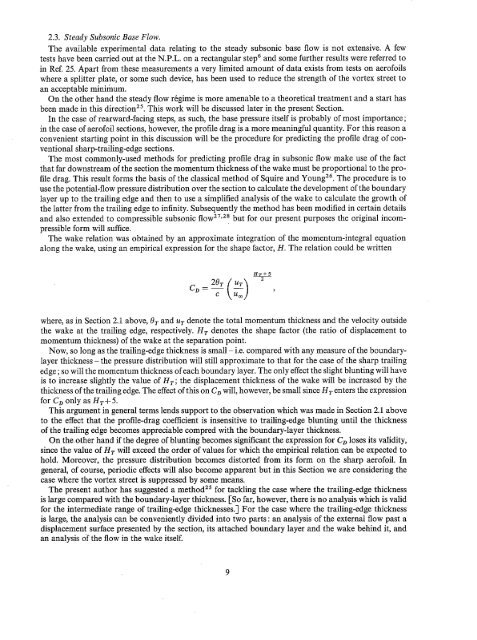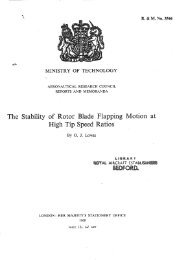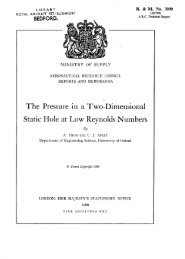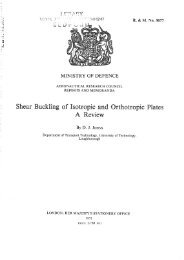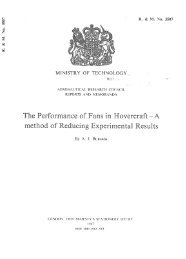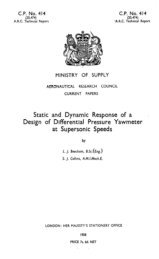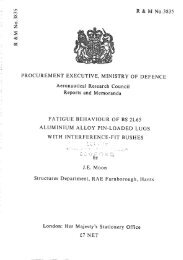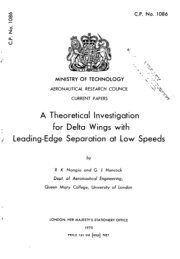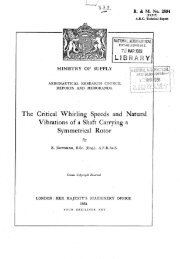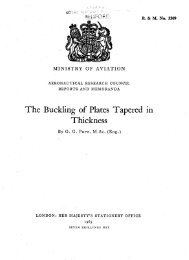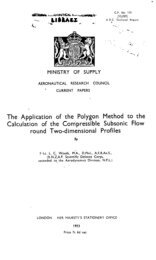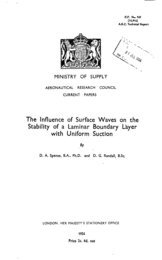A Discussion of Two-Dimensional Turbulent Base Flows - aerade
A Discussion of Two-Dimensional Turbulent Base Flows - aerade
A Discussion of Two-Dimensional Turbulent Base Flows - aerade
Create successful ePaper yourself
Turn your PDF publications into a flip-book with our unique Google optimized e-Paper software.
2.3. Steady Subsonic <strong>Base</strong> Flow.<br />
The available experimental data relating to the steady subsonic base flow is not extensive. A few<br />
tests have been carried out at tl~e N.P.L. on a rectangular step 6 and some further results were referred to<br />
in Ref. 25. Apart from these measurements a very limited amount <strong>of</strong> data exists from tests on aer<strong>of</strong>oils<br />
where a splitter plate, or some such device, has been used to reduce the strength <strong>of</strong> the vortex street to<br />
an acceptable minimum.<br />
On the other hand the steady flow r6gime is more amenable to a theoretical treatment and a start has<br />
been made in this direction 25. This work will be discussed later in the present Section.<br />
In the case <strong>of</strong> rearward-facing steps, as such, the base pressure itself is probably <strong>of</strong> most importance;<br />
in the case <strong>of</strong> aer<strong>of</strong>oil sections, however, the pr<strong>of</strong>ile drag is a more meaningful quantity. For this reason a<br />
convenient starting point in this discussion will be the procedure for predicting the pr<strong>of</strong>ile drag <strong>of</strong> con-<br />
ventional sharp-trailing-edge sections.<br />
The most commonly-used methods for predicting pr<strong>of</strong>ile drag in subsonic flow make use <strong>of</strong> the fact<br />
that far downstream <strong>of</strong> the section the momentum thickness <strong>of</strong> the wake must be proportional to the pro-<br />
file drag. This result forms the basis <strong>of</strong> the classical method <strong>of</strong> Squire and Young 26. The procedure is to<br />
use the potential-flow pressure distribution over the section to calculate the development <strong>of</strong> the boundary<br />
layer up to the trailing edge and then to use a simplified analysis <strong>of</strong> the wake to calculate the growth <strong>of</strong><br />
the latter from the trailing edge to infinity. Subsequently the method has been modified in certain details<br />
and also extended to compressible subsonic flow 2v'28 but for our present purposes the original incom-<br />
pressible form will suffice.<br />
The wake relation was obtained by an approximate integration <strong>of</strong> the momentum-integral equation<br />
along the wake, using an empirical expression for the shape factor, H. The relation could be written<br />
where, as in Section 2.1 above, O<br />
r and UT denote the total momentum thickness and the velocity outside<br />
the wake at the trailing edge, respectively. H r denotes the shape factor (the ratio <strong>of</strong> displacement to<br />
momentum thickness) <strong>of</strong> the wake at the separation point.<br />
Now, so long as the trailing-edge thickness is small -i.e. compared with any measure <strong>of</strong> the boundary-<br />
layer thickness - the pressure distribution will still approximate to that for the case <strong>of</strong> the sharp trailing<br />
edge ; so will the momentum thickness <strong>of</strong> each boundary layer. The only effect the slight blunting will have<br />
is to increase slightly the value <strong>of</strong> HT; the displacement thickness <strong>of</strong> the wake will be increased by the<br />
thickness <strong>of</strong> the trailing edge. The effect <strong>of</strong> this on CD will, however, be small since Hr enters the expression<br />
for CD only as Hr+5.<br />
This argument in general terms lends support to the observation which was made in Section 2.1 above<br />
to the effect that the pr<strong>of</strong>ile-drag coefficient is insensitive to trailing-edge blunting until the thickness<br />
<strong>of</strong> the trailing edge becomes appreciable compred with the boundary-layer thickness.<br />
On the other hand if the degree <strong>of</strong> blunting becomes significant the expression for CD loses its validity,<br />
since the value <strong>of</strong> HT will exceed the order <strong>of</strong> values for which the empirical relation can be expected to<br />
hold. Moreover, the pressure distribution becomes distorted from its form on the sharp aer<strong>of</strong>oil. In<br />
general, <strong>of</strong> course, periodic effects will also become apparent but in this Section we are considering the<br />
case where the vortex street is suppressed by some means.<br />
The present author has suggested a method 25 for tackling the case where the trailing-edge thickness<br />
is large compared with the boundary-layer thickness. [So far, however, there is no analysis which is valid<br />
for the intermediate range <strong>of</strong> trailing-edge thicknesses.] For the case where the trailing-edge thickness<br />
is large, the analysis can be conveniently divided into two parts : an analysis <strong>of</strong> the external flow past a<br />
displacement surface presented by the section, its attached boundary layer and the wake behind it, and<br />
an analysis <strong>of</strong> the flow in the wake itself.<br />
HT+ 5<br />
2


